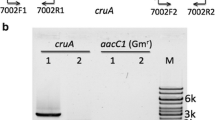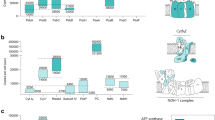Abstract
The Clp family consists of large, ubiquitous proteins that function as molecular chaperones and/or regulators of ATP-dependent proteolysis. A single copy gene coding for one of these proteins, ClpC, was cloned from the unicellular cyanobacterium Synechococcus sp. PCC 7942. The predicted polypeptide is most similar (ca. 88%) to the chloroplast-localized ClpC protein from higher plants. Using degenerate PCR primers specific for the two distinct ATP-binding domains characteristic of all ClpA-C proteins, partial sequences homologous to clpC from Synechococcus were also identified in five other cyanobacterial strains. The Synechococcus clpC gene is transcribed under standard growth conditions as a monocistronic message of around 2.7 kb. The level of this message, however, decreases slightly after a shift from 37 to 47.5°C for 2 h, similar to expression previously observed for clpC mRNA from heat-shocked higher plants. At the protein level, the amount of ClpC remains relatively unchanged during the high temperature shift, while that of the known heat shock protein GroEL rises considerably. In contrast, the constitutive level of ClpC in Synechococcus increases considerably under conditions of rapid growth, both with increasing light intensities or CO2 concentrations. This, and the fact that attempts to inactivate clpC expression fail to produce a viable phenotype, suggest that ClpC activity is essential for growth in this obligate photoautotrophic cyanobacterium.
Similar content being viewed by others
References
Campbell D, Zhou G, Gustafsson P, Öquist G, Clarke AK: Electron transport regulates exchange of two forms of photosystem II D1 protein in the cyanobacterium Synechococcus. EMBO J 14: 5457–5466 (1955).
Clarke AK, Critchley C: The identification of a heat shock protein complex in chloroplasts of barley leaves. Plant Physiol 100: 2081–2089 (1992).
Clarke AK, Soitamo A, Gustafsson P, Öquist G: Rapid interchange between two distinct forms of cyanobacterial photosystem II reaction-center protein D1 in response to photoinhibition. Proc Natl Acad Sci USA 90: 9973–9977 (1993).
Clarke AK, Gustafsson P, Lidholm JÉ: Identification and expression of the chloroplast clpP gene in the conifer Pinus contorta. Plant Mol Biol 26: 851–862 (1994).
Clarke AK, Campbell D, Gustafsson P, Öquist G: Dynamic responses of photosystem II and phycobilisomes to changing light in the cyanobacterium Synechococcus sp. PCC 7942. Planta 197: 553–562 (1995).
Devreux J, Haeberli P, Smithies O: A comprehensive set of sequence analysis programs for the VAX. Nucl Acids Res 12: 387–395 (1984).
Ellis RJ, van derVies SM: Molecular chaperones. Annu Rev Biochem 60: 321–347 (1991).
Feinberg AP, Volgelstein B: A technique for radiolabelling DNA endonuclease fragments to high specific activity. Anal Biochem 132: 6–13 (1983).
Gottesman S, Maurizi MR: Regulation by proteolysis: energy-dependent proteases and their targets. Microbiol Rev 56: 592–621 (1992).
Hammond JBW, Preiss J: ATP-dependent proteolytic activity from spinach leaves. Plant Physiol 73: 902–905 (1983).
Hwang BJ, Park WJ, Chung CH, Goldberg AL: Escherichia coli contains a soluble ATP-dependent protease (Ti) distinct from protease La. Proc Natl Acad Sci USA 84: 5550–5554 (1987).
Katayama-Fujimura YS, Gottesman S, Maurizi MR: A multiple-component, ATP-dependent protease from Escherichia coli. J Biol Chem 262: 4477–4485 (1987).
Kohchi T, Ogura Y, Umesono K, Yamada Y, Komano T, Ozeki H, Ohyama K: Ordered processing and splicing in a polycistronic transcript in liverwort chloroplasts. Curr Genet 14: 147–154 (1988).
Koller B, Fromm H, Galun E, Edelman M: Evidence for in vivo trans splicing of pre-mRNAs in tobacco chloroplasts. Cell 48: 11–119 (1987).
Krüger E, Völker U, Hecker M: Stress induction of clpC in Bacillus subtilis and its involvement in stress tolerance. J Bact 176: 3360–3367 (1994).
Lee Y-RJ, Nagao RT, Key JL: A soybean 100-kD heat shock protein complements a yeast HSP 104 deletion mutant in acquiring thermotolerance. Plant Cell 6: 1889–1897 (1994).
Lehel C, Los D, Wada H, Györgyey J, Horváth I, Kovács E, Murata N, Vigh L: A second groEL-like gene, organized in a groESL operon is present in the genome of Synechocystis PCC 6803. J Biol Chem 268: 1799–1804 (1993).
Leonhardt SA, Fearon K, Danese PN, Mason TL: Hsp78 encodes a yeast mitochondrial heat shock protein in the Clp family of ATP-dependent proteases. Mol Cell Biol 13: 6304–6313 (1993).
Maurizi MR: ATP-promoted interaction between ClpA and ClpP in activation of Clp protease from Escherichia coli. Biochem Soc Trans 19: 719–723 (1991).
Maurizi MR, Clark WP, Katayama Y, Rudikoff S, Pumphrey J, Bowers B, Gottesman S: Sequence and structure of ClpP, the proteolytic component of the ATP-dependent Clp protease of Escherichia coli. J Biol Chem 265: 12536–12545 (1990).
Maurizi MR, Clark WP, Kim S-H, Gottesman S: ClpP represents a unique family of serine proteases. J Biol Chem 265: 12546–12552 (1990).
Moore T, Keegstra K: Characterization of a cDNA clone encoding a chloroplast targeted Clp homologue. Plant Mol Biol 21: 525–537 (1993).
Msadek T, Kunst F, Rapoport G: MecB of Bacillus subtilis, a member of the ClpC ATPase family, is a pleiotrophic regulator controlling competence gene expression and growth at high temperature. Proc Natl Acad Sci USA 91: 5788–5792 (1994).
Myers J, Graham JR, Wang RT: Light harvesting in Anacystis nidulans studied in pigment mutants. Plant Physiol 66: 1144–1149 (1980).
Nimura K, Yoshikawa H, Takahashi H: Identitication of dnaK multigene family in Synechococcus sp. PCC 7942. Biochem Biophys Res Commun 201: 466–471 (1994).
Parsell DA, Sanchez Y, Stitzel JD, Lindquist S: Hsp104 is a highly conserved protein with two essential nucleotide-binding sites. Nature 353: 270–273 (1991).
Parsell DA, Lindquist S: The function of heat-shock proteins in stress tolerance: degradation and reactivation of damaged proteins. Annu Rev Genet 27: 437–496 (1993).
Parsell DA, Kowal AS, Singer MA, Lindquist S: Protein disaggregation mediated by heat-shock protein Hsp 104. Nature 372: 475–478 (1994).
Rippka R, Deruelles J, Waterbury JB, Herdman M, Stanier RY: Generic assignments, strain histories and properties of pure cultures of cyanobacteria. J Gen Microbiol 111: 1–61 (1979).
Sanchez Y, Lindquist SL: HSP 104 required for induced thermotolerance. Science 248: 1112–1115 (1990).
Schirmer EC, Lindquist S, Vierling E: An arabidopsis heat shock protein complements a thermotolerance defect in yeast. Plant Cell 6: 1899–1909 (1994).
Schmitt M, Neupert W, Langer T: Hsp78, a Clp homologue within mitochondria, can substitute for chaperone functions of mt-hsp 70. EMBO J 14: 3434–3444 (1995).
Shanklin J, DeWitt ND, Flanagan JM: The stroma of higher plant plastids contain ClpP and ClpC, functional homologs of Escherichia coli ClpP and ClpC: an archetypal two-component ATP-dependent protease. Plant Cell 7: 1713–1722 (1995).
Squires C, Squires CL: The Clp proteins: proteolysis regulators or molecular chaperones? J Bact 174: 1081–1085 (1992).
Thiel T: Genetic analysis of cyanobacteria. In: Bryant DA (ed) The Molecular Biology of the Cyanobacteria, pp. 581–611. Kluwer Academic Publishers, Dordrecht, Netherlands (1994).
Thompson MW, Maurizi MR: Activity and specificity of Escherichia coli ClpAP protease in cleaving model peptide substrates. J Biol Chem 269: 18201–18208 (1994).
Wawrzynow A, Wojtkowiak D, Marszalek J, Banecki B, Jonsen M, Graves B, Georgopoulos C, Zylicz M: The ClpX heat-shock protein of Escherichia coli, the ATP-dependent substrate specificity component of the ClpP-ClpX protease, is a novel molecular chaperone. EMBO J 14: 1867–1877 (1995).
Webb R, Reddy KJ, Sherman LA: Regulation and sequence of the Synechococcus sp. strain PCC 7942 groESL operon, encoding a cyanobacterial chaperonin. J Bact 172: 5079–5088 (1990).
Wickner S, Gottesman S, Skowrya D, Hoskins J, McKenney K, Maurizi MR: A molecular chaperone, ClpA, functions like DnaK and DnaJ. Proc Natl Acad Sci USA 91: 12218–12222 (1994).
Wojtkowiak D, Georgopoulos C, Zylicz M: Isolation and characterization of ClpX, a new ATP-dependent specificity component of the Clp protease of Escherichia coli. J Biol Chem 268: 22609–22617 (1993).
Author information
Authors and Affiliations
Rights and permissions
About this article
Cite this article
Clarke, A.K., Eriksson, MJ. The cyanobacterium Synechococcus sp. PCC 7942 possesses a close homologue to the chloroplast ClpC protein of higher plants. Plant Mol Biol 31, 721–730 (1996). https://doi.org/10.1007/BF00019460
Received:
Accepted:
Issue Date:
DOI: https://doi.org/10.1007/BF00019460




